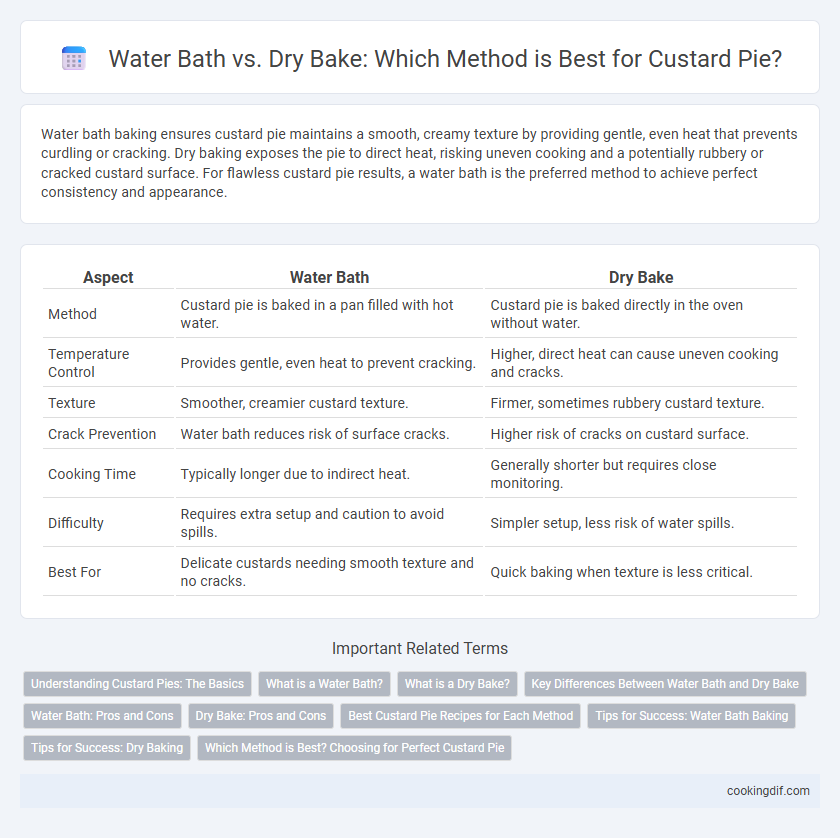Water bath baking ensures custard pie maintains a smooth, creamy texture by providing gentle, even heat that prevents curdling or cracking. Dry baking exposes the pie to direct heat, risking uneven cooking and a potentially rubbery or cracked custard surface. For flawless custard pie results, a water bath is the preferred method to achieve perfect consistency and appearance.
Table of Comparison
| Aspect | Water Bath | Dry Bake |
|---|---|---|
| Method | Custard pie is baked in a pan filled with hot water. | Custard pie is baked directly in the oven without water. |
| Temperature Control | Provides gentle, even heat to prevent cracking. | Higher, direct heat can cause uneven cooking and cracks. |
| Texture | Smoother, creamier custard texture. | Firmer, sometimes rubbery custard texture. |
| Crack Prevention | Water bath reduces risk of surface cracks. | Higher risk of cracks on custard surface. |
| Cooking Time | Typically longer due to indirect heat. | Generally shorter but requires close monitoring. |
| Difficulty | Requires extra setup and caution to avoid spills. | Simpler setup, less risk of water spills. |
| Best For | Delicate custards needing smooth texture and no cracks. | Quick baking when texture is less critical. |
Understanding Custard Pies: The Basics
Water bath baking maintains even, gentle heat, preventing curdling and promoting a smooth custard texture in pies. Dry baking risks uneven cooking and a rubbery or cracked custard due to direct exposure to oven heat. Understanding these methods helps achieve the ideal creamy consistency essential for classic custard pies.
What is a Water Bath?
A water bath, also known as a bain-marie, is a cooking method where a custard pie dish is placed in a larger pan filled with hot water to ensure gentle, even heat around the pie. This technique prevents curdling and cracks by maintaining consistent moisture and temperature during baking. Water baths are essential for delicate custards, delivering a smooth, creamy texture compared to the firmer result of dry baking.
What is a Dry Bake?
A dry bake for custard pie involves baking the pie without adding water to the oven, relying solely on direct heat to cook the filling and crust. This method creates a firmer texture and a slightly caramelized top, as the custard sets through consistent dry heat. Unlike a water bath, a dry bake can result in a richer flavor but requires careful temperature control to prevent cracking or overbaking.
Key Differences Between Water Bath and Dry Bake
Water bath baking for custard pie involves placing the pie dish in a larger pan filled with hot water, promoting gentle, even heat and preventing curdling or cracking. Dry bake method uses direct oven heat on the pie, which can result in a firmer texture but carries a higher risk of uneven cooking and cracking. Key differences include moisture retention, temperature control, and final texture, with water bath ensuring smooth, creamy custard and dry bake yielding a denser custard consistency.
Water Bath: Pros and Cons
Water bath baking for custard pies ensures gentle, even heat distribution, preventing curdling and resulting in a smooth, creamy texture. It maintains moisture around the pie, reducing the risk of cracking and overbaking. However, water baths require careful monitoring to avoid water seeping into the crust, which can cause sogginess and extended baking times.
Dry Bake: Pros and Cons
Dry baking custard pie produces a firmer, more set texture due to the direct heat exposure, which improves the crust's crispness and prevents sogginess. However, this method increases the risk of overcooking the custard, leading to cracks or a rubbery consistency, especially without careful temperature control. While dry baking simplifies the process by avoiding water handling, it may require frequent monitoring to maintain the ideal creamy custard consistency.
Best Custard Pie Recipes for Each Method
Water bath baking ensures even, gentle heat distribution, preventing curdling and resulting in a smooth, creamy custard perfect for delicate recipes like classic vanilla or lemon custard pies. Dry bake offers a firmer texture with a slightly caramelized top, ideal for rich, dense custards such as pumpkin or sweet potato pies. Selecting the optimal method depends on the desired custard consistency and recipe specifics to achieve the best flavor and texture balance.
Tips for Success: Water Bath Baking
Using a water bath for custard pie ensures even heat distribution and prevents the edges from overcooking or cracking. Place the pie pan in a larger baking dish filled with hot water halfway up the pie crust to maintain gentle, consistent moisture during baking. Covering the crust edges with foil helps avoid excessive browning while the water bath prevents curdling and yields a silky, smooth custard texture.
Tips for Success: Dry Baking
Dry baking custard pie requires precise temperature control, ideally baking at 325degF to avoid curdling and ensure even cooking. Use a pie shield or foil to protect the crust from over-browning while allowing the filling to set properly. Let the pie cool gradually at room temperature to achieve a smooth, creamy texture and prevent cracks on the surface.
Which Method is Best? Choosing for Perfect Custard Pie
Water bath baking is the preferred method for achieving a silky smooth custard pie, as it provides gentle, even heat that prevents the custard from curdling or cracking. Dry baking often leads to uneven cooking and a rubbery texture due to direct exposure to high heat. For consistently perfect custard pies, a water bath ensures the ideal creamy texture and a flawless, crack-free surface.
Water bath vs dry bake for custard pie Infographic

 cookingdif.com
cookingdif.com